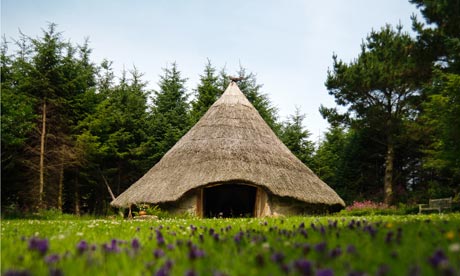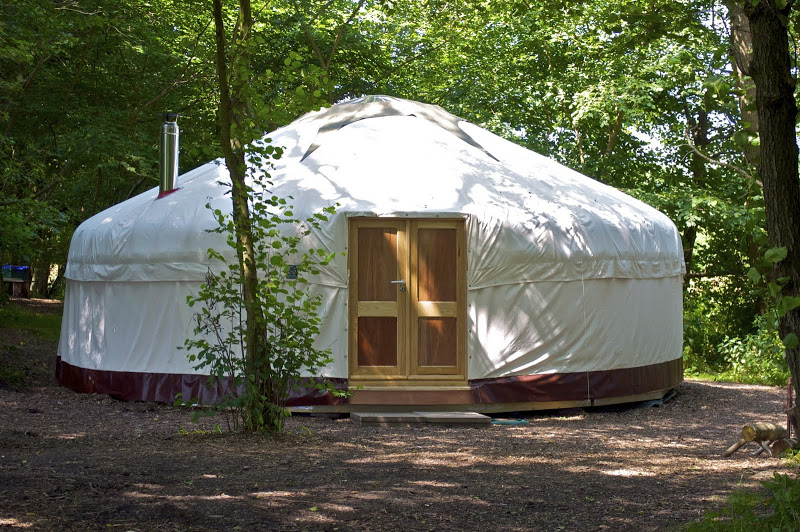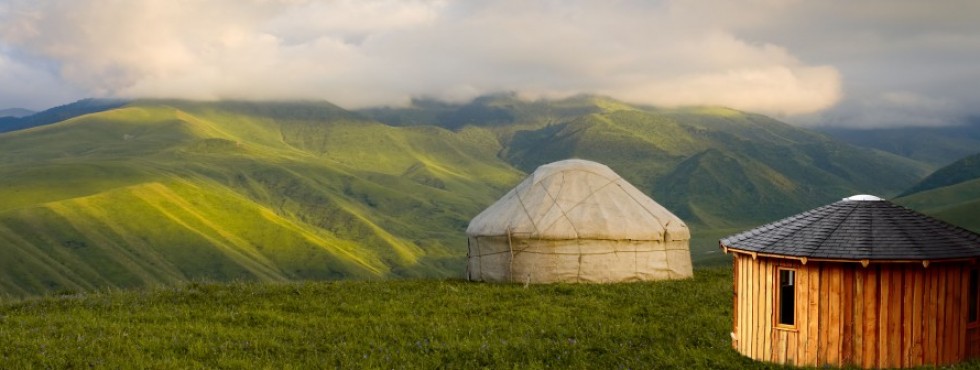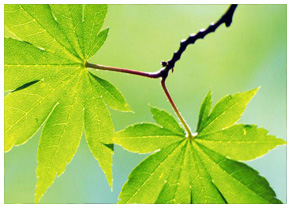The
Modern,
Sustainable
Equivalent
to
the
Yurt
It
goes
without
saying;
we
are
deeply
passionate
about
Round
Structures
!
Many are surprised and curious as to why we wish to build exclusively 'in the round' but we actually have more reasons to build to a circular footprint than any other form. In all honesty, we aren't actually doing anything new; we're just reviving a form of architecture which has existed for thousands of years. Instinctively, we know that our Rotundas are positively refreshing (and a joy to spend time in!) and we draw our inspiration not only from ancient and nomadic cultures, but also by researching emerging trends within contemporary eco-builds. This helps us identify exactly why the circular footprint is so special and what a circular space can provide for it's inhabitants, albeit just for a weekend getaway or a place to study. Below are a few examples of building 'in the round' and the many reasons for doing so:

Roundhouses have been built in Britain since the Iron Age to the early Roman period (600BC - 250AD). They used walls made either of stone or of wooden posts joined by wattle-and-daub panels and a conical thatched roof. The Atlantic roundhouse, Broch and Wheelhouse styles were used in Scotland. Iron Age people displayed a great love of decoration and ornament - swords, shields, torcs etc were beautifully worked with their distinctive artistic style based on geometric circles. Typically, a 'roundhouse' would be between 6 and 15 metres in diameter. It is assumed that the walls would have been at least chest height, to allow maximum use of the enclosed space. Often, the house's entrance, which might have a porch, faces east or south-east – away from prevailing westerly winds, but, perhaps more importantly (for reasons of belief), towards the rising sun. You can see modern reconstructions of Roundhouses over the UK, Castell Henllys (nestled deep in the Pembrokeshire Coast National Park) is one of many prehistoric promontory forts in the National Park dating to around 600BC. Castell Henllys was occupied from c.500BC to c.100BC. It was, allegedly, crowded with roundhouses, and may have had a population of 100–150 people. The Roundhouse (shown above) in Cornwall sleeps two and costs from £150 a night. It is available March to October. Book through Canopy and Stars (canopyandstars.co.uk)

The yurt is the traditional dwelling of the Mongolian nomads. It has a circular shape, is supported by a collapsible wooden frame, and is covered by wool felt. Yurts have been in use at least since the 13th century and originated in the high mountain steppes of central Asia. A common arrangement of a yurt camp in the medieval Mongolia was huree (kuren) (meaning “circle”), in which the yurt of the khan or chieftain was located in the centre and the yurts of the other members of the tribe were placed around it. Modern yurts are typically made from more contemporary materials (aluminium rivets, aircraft cable, and polyester materials) with heat-treated and fine finished wood. Yet their basic architectural principle (circular arch) remains the same as used five hundred years ago. Yurts have many advantages, both tangible and intangible; An ancient nomadic shelter, yurts provide a reprieve from the rectilinear excesses of modern culture and remind us, through their circular form, of the unity and interconnectedness of all things. The Yurt roof incorporates a unique architectural design, roof struts meet in a central ring producing downward and inward pressure. A tension cable (at the top of the wall) holds the roof and wall together in a state of compression enabling large roof spans without the requirement for additional poles or trusses. This gives the yurt an incredible and uplifting feeling of spaciousness and is stronger than the roof on a rectilinear building (capable of withstanding heavy snow loads, earthquakes and strong winds). Yurts are hugely popular in the UK at the moment as 'glamping' (glamorous camping); units – alternative holiday abodes; they're larger and more functional than a tent and are a quirky and exciting place to stay – yurts can be fitted with log burning stoves and plumbing facilities but are subject to quite a lot of maintenance (it is recommended that they are taken down if they are left unused for several months), in addition, intermittent waterproofing and the odd spell of rope-tightening may be required. There are several beautiful Yurt sites in the UK which we'd recommend you visit – to stay in the Yurt featured on this page please visit WoWo Campsite in East Sussex, they have several yurts and even a shepherds hut: http://www.wowo.co.uk

Local superstition holds that evil spirits are everywhere, especially along roads and in brooks, streams and mountain passes. Every corner in a rectangular building is an opportunity for evil spirits to enter the building as the circular tulou have no corners, spirits are more likely to pass by."
(Huang Hanmin in Echo (ref: note 12)). No contemporary sources explain exactly why circular tulou were built but the circular form has several advantages:
- Technically a circular form is easier to build because of the identical cross-section throughout and without the need for complex roof and wall corner construction.
- The circular form allows more economic use of material.
- A circular building has a greater static stability.
- The circular tulou has a more uniform room division - As the main source of light is from the courtyard, a corner room would be poorly lit and without adequate ventilation.
Tulou buildings have been inscribed in 2008 by UNESCO as a World Heritage Site and praised as 'exceptional examples of a building tradition and function exemplifying a particular type of communal living and defensive organization in a harmonious relationship with their environment'.

The Roundhouse is a Grade II* listed former railway engine shed in the colourful Camden area of London, England. Nowadays it's known as a performing arts and concert venue. It was originally built in 1847 as a roundhouse, a circular building containing a railway turntable, but was only used for railway purposes for about a decade. After being used as a warehouse for a number of years, the building fell into disuse just before the Second World War. It reopened twenty-five years later, as a performing arts venue and was declared a National Heritage Site in 2010. This large circular structure has hosted various notable promotions, such as the launch of the underground paper International Times in 1966,The Doors only UK appearance in 1968 and Greasy Truckers Party in 1972. Since it's redevelopment between 2004-2006, the Roundhouse now houses a state of the art creative center for 11-25 year olds, has undergone major restoration works of many of the original features and boasts a new wing to house modern amenities. The Roundhouse's incredible history intermingled with art, technology, and social media speaks the nature of this epic building and we love the fact that it now stands to encourage and inspire creativity and music in young people. In addition, the acoustics in a circular building are out of this world; to perform in the Roundhouse must be magical as the music amplifies around the curves.

This new build Primary School in Wales was completed in 2009 and was designed by Neath Port Talbot County Borough Council. It's a fascinating building, made up of impressive round pods. All eight classrooms at the 'revolutionary' new school are built on a circular plan. Teachers will stand in the middle with pupils sitting in a circle all around them. Jonathan Morris of Neath Port Talbot County Borough Council, comments: “A lot of time and research went into designing the school, focusing on inclusivity and sustainability – essentially tailoring the design dependant on how it was to be used. We wanted to ensure we designed a one-off bespoke school that was different and interesting, and not just your average square school building.” Teachers and architects say it is the shape of things to come, 'No one is at the back of the class and no one is at the front. It's all-inclusive,' said Gareth Nutt, spokesman for Neath Port Talbot Council.










